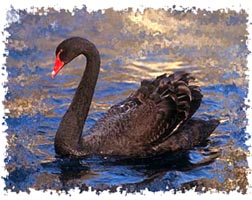

The Black Swan, (Cygnus atratus), is a bird of Australia, including Tasmania.
Black Swans are from 44 to 55 inches with a wing span of 6 feet . The plumage is black, the tips of the wings are white. Immature Black Swans are light grayish brown. Swans molt once a year during which time they are flightless.
The bills are red and white with fine grooves that enable them to feed on underwater plants. Their legs and webbed feet are black. They do not dive for food but are able to reach the plants they feed on with their long necks.
During February through September, the Black Swans begin building their nests. These large birds, who mate for life, often nest in colonies, unlike other swans. The nest is a large affair built of sticks and vegetation. Both birds build the nest.
The female lays 4 to 8 pale green eggs. Both parents tend the nest. The incubation period is about 35 - 40 days. The young swans, called cygnets, are covered with a fluffy gray-colored down that they keep for 3 - 4 weeks. The cygnets can swim soon after hatching and learn to feed themselves. They also may ride on their parent's back for longer trips into deeper water. The young birds leave the family unit to begin lives of their own in about nine months.



